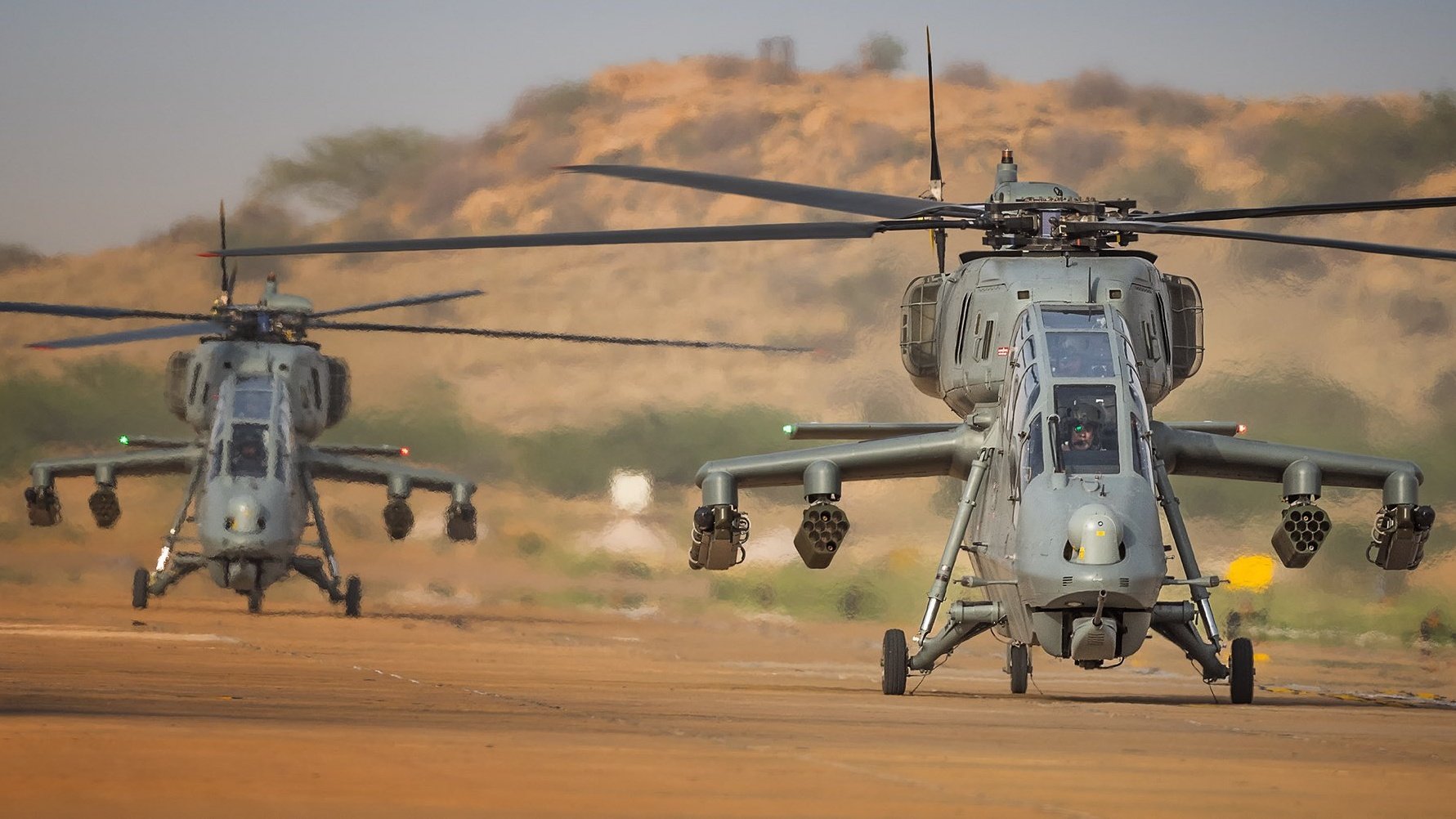India’s domestically-built Light Combat Helicopter (LCH) ‘Prachand’ (Fierce), American-built Chinook, and Apache ‘tank-killers helicopters roared on the country’s western frontier in a massive air exercise that saw the participation of 120 aircraft, including Rafale, Su-30MKI, MiG-29, Mirage-2000 and Light Combat Aircraft Tejas. This is the first participation of LCH in the IAF’s firepower demonstration.
The Apache attack helicopter demonstrated its firepower in this event for the first time by engaging targets with air-to-ground guided missiles, while Mi-17 helicopters engaged ground targets with rockets.
As another first, IAF Chinook helicopters demonstrated rapid deployment of combat assets by airlifting the Indian Army’s M-777 Ultra-Light Howitzers in an underslung mode, enabling prompt destruction of simulated enemy targets on the ground.
Night events in the exercise called ‘Lightning Strike from the Sky’ displayed for the first time the capabilities of indigenous LCH ‘Prachand,’ wherein it neutralized designated targets with rockets.
In two hours, the IAF dropped 40 to 50 tonnes of ordnance within a one to two-kilometer radius. The platforms taking part in the exercise for the first time include Rafales, Prachand light combat helicopters, and Samar surface-to-air weapon system,”
#WATCH | Jaisalmer, Rajasthan: Indian Air Force C-17 heavy lift transport aircraft dropping logistics supplies in Pokharan during the ongoing Exercise Vayushakti-2024 there. pic.twitter.com/FLAiJcRCSm
— ANI (@ANI) February 17, 2024
The LCH Prachand is India’s first indigenous multi-role combat helicopter with potent ground attack and aerial combat capability. It has been customized as per the Indian armed forces’ requirement to operate in deserts and mountains.
LCH, along with LCA, is one of the flagship products designated for exports from the Indian aerospace maker Hindustan Aeronautics Limited (HAL). Argentina and Nigeria have shown interest in rotary-wing aircraft. Argentina signed a letter of intent to purchase 20 ‘Prachand’ helicopters.
The Indian Army and the IAF inducted the LCH in its fleet in 2022. The army intends to deploy these aircraft on its border with Pakistan and China.
LCH Prachand is produced as part of a collaboration between HAL and France’s Safran company powered by twin Shakti engines.
The helicopter can fly at a maximum speed of 288 mph, has a combat radius of 500 km, and a service ceiling of 21,000 feet, which means it can operate at the world’s highest battleground – the Siachen Glacier.
The pilot and co-pilot, known as the Weapon Systems Operator (WSO), sit in tandem in a glass cockpit and are protected by armored panels.
The weapon complement includes a 20mm nose gun in the front, capable of firing 800 rounds per minute from a range of up to 2 km. A 70mm rocket pod is mounted on the stub wing, with a direct firing range of up to 4 km and indirect up to 8 km.
Above the gun is an electro-optical pod for long-range day and night surveillance and target tracking. Anti-tank guided missile ‘Dhruvastra’ and French air-to-air missile ‘Mistral-2’ have a maximum interception range of 6.5 km.
The helicopter was developed by India after its Russian Mi-25 and Mi-35 proved ineffective during the Kargil Conflict against Pakistan in 1999. The Indian defense establishment built a lighter, stealthier, and more maneuverable attack helicopter. The designs for a LCH were first drawn up in 2003.
The government sanctioned the indigenous LCH project in 2006. After a few hiccups and relentless work of over a decade, extensive flight testing was carried out on four prototypes, and operational clearances came between 2017 and 2019.
During its testing, the LCH landed at a forward base in the region, 4,700 meters above sea level, and with a 500-kg load. It is the only helicopter operating at 5,000 meters with a considerable load of weapons and fuel.
The power-packed display of Rafale at #VayuShakti24!@IAF_MCC @DefenceMinIndia @SpokespersonMoD #IndianAirForce #VayuShakti pic.twitter.com/lsn9hWsKn1
— Doordarshan National दूरदर्शन नेशनल (@DDNational) February 17, 2024
IAF’s Diverse Fleet
US-made Chinook, twin-engine, tandem rotor is a multi-role, vertical-lift platform used to transport troops, artillery, equipment, and fuel. Four Chinooks were inducted into the IAF in March 2019.
Eight US-made Apache stealth attack helicopters were inducted into the IAF in September 2019, significantly boosting the force’s firepower capability.
Both of them have been deployed along the Eastern frontier during the long standoff with China. Apache attack helicopters in Ladakh provided tactical support to the ground forces if needed, besides using the Chinook heavy-weight choppers to help move men and equipment amid tensions with China.

India has been consciously veering away from Russian weapon platforms. The Indian Armed Forces are either inducting indigenous weapons or forming strategic defense partnerships with governments directly.
The US has emerged as a reliable source of defense equipment – from helicopters, military airlifters, and howitzers. The ‘Vayu Shakti’ drills demonstrated this shift in the IAF’s fleet.
In the 2019 edition, Vayu Shakti involved light combat aircraft Tejas pounding simulated enemy installations with 2,000lb bombs, Su-30s launching the locally produced Astra missile to take down a ‘hostile jet,’ MiG-21s raining rockets on targets depicting an armored column and MiG-27s taking out a bunker complex with bombs. Also, Mirage-2000 jets attacked simulated targets with 250-kg bombs.
- Ritu Sharma has been a journalist for over a decade, writing on defense, foreign affairs, and nuclear technology.
- She can be reached at ritu.sharma (at) mail.com
- Follow EurAsian Times on Google News




